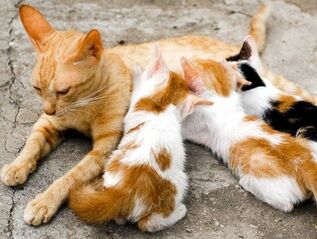what is a community cat?
A Community Cat is an un-owned, un-socialized cat who lives his/her life outdoors. That is different than a stray cat who has been socialized around humans, but was abandoned or lost outdoors. While stray cats can be brought to a shelter and re-homed with another human family, community cats can NEVER be placed in a home or brought to shelter. Community cats are essentially wild animals, who live outside in our communities around the world; they are some of the first cats to be killed in shelters as they are not adoptable. Please know that these outdoor community cats are more than able to survive the cold; they know where to find shelter and just like our other furry friends outside, these cats will get thick warm coats.
You've probably heard the term "feral cats." Feral is often used to describe outdoor cats, however, "feral" is actually a behavior. While community cats may display feral behavior (fear and avoidance of humans), other may actually be more trusting of humans; using the more encompassing term of "community cat" is preferred.
You've probably heard the term "feral cats." Feral is often used to describe outdoor cats, however, "feral" is actually a behavior. While community cats may display feral behavior (fear and avoidance of humans), other may actually be more trusting of humans; using the more encompassing term of "community cat" is preferred.
what is trap-neuter-return, aka tnr?
T = Trap community cats in a safe, humane live trap
N = Neuter or spay community cats by a veterinarian
R = Return community cats to their outdoor colony
N = Neuter or spay community cats by a veterinarian
R = Return community cats to their outdoor colony
The practice of TNR enables community cats to live out their lives without adding to the overpopulation of homeless cats in our shelter system. Community cats are trapped in humane live traps, sterilized at a local vet hospital, and then released back into their outdoor colony.
full circle APPROACH
|
Kittens do not magically appear out of thin air, they are the result of unaltered cats breeding. Just rescuing and placing kittens into homes, but leaving the adults outside to continue breeding, is like trying to bail water out of a boat with a hole in the bottom. By practicing a "full circle" approach, we can make sure that no more kittens will be born outside to an uncertain fate.
|
I found a litter of kittens outside, what do I do?
Before picking up a kitten, assess the situation using the CASA method, courtesy of the Kitten Lady. Consider these 4 factors: Condition, Age, Situation, and Ability.
Don't forget, where there are kittens, there are unsterilized breeding adults. Always look for rescues and resources to help get the adults and older kittens sterilized, or you'll be right back in this same situation a few weeks down the road.
Keep in mind that no two scenarios are alike. There are numerous lifesaving pathways depending on the kittens condition, age, situation and the abilities and resources at your disposal.
Not sure how old a kitten is, click here to view a guide.
Keep in mind that no two scenarios are alike. There are numerous lifesaving pathways depending on the kittens condition, age, situation and the abilities and resources at your disposal.
Not sure how old a kitten is, click here to view a guide.
Take action
Now that you're armed with all this knowledge, how do you take action? The best resource is to actually just Google: "tnr groups near me." That will produce a list of groups with resources to help with your community cats; their ability to help may vary.
Sadly, we at NBAR cannot provide any TNR resources at this time.
- Also, be sure to check out: All About Animals for training on trapping and additional resources.
Sadly, we at NBAR cannot provide any TNR resources at this time.
ear tips - it's hip to be tipped
|
You may see a community cat with an ear tip. This is the universal sign that this cat (1) is spayed or neutered and (2) has a caretaker. Leave this cat where it's at!
When cats are sedated for sterilization, a veterinarian will "tip" one of the cats ears; since the cat is sedated, this is a painless procedure. The ear tip does not affect them, and is a clear visual signal for us. The goal is to have every community cat in a colony ear tipped; any cats without a tip indicates that they need to go through TNR. |
why not just catch and kill all the cats?
Many people feel that it's "unfair" or "cruel" to keep these cats outside, but remember - they were born outside with little to no human contact. Their home is outside! You would not try to bring in a wild raccoon to make it a pet in your home, would you? Aside from moral issues of just killing cats, studies have shown that just removing a colony will result in new cats taking over - you are basically creating a vacuum effect; more and more new cats will come to fill the vacuum left by removing the original cats of the colony. The TNR method has shown over and over again, its the only effective way to stabilize and eventually reduce a colony in a community.
can the cats be released somewhere else?
The short answer is "no." These cats are suited and adapted to the community the live in now. They know the places to get food, water, shelter; they know the members of their colony and have close connections with some of their colony members. They know their home and moving them to a new location greatly decreases their chances of surviving.
benefits to the community
Many of the unwanted behaviors of outdoor cats are relieved by TNR. As mentioned, colonies that are fully TNR will stabilize and over time, reduce naturally. Neutered male cats will no longer spray to mark territories or get into fights over females. Spayed female cats won't go into heat, so no more 3am howling for a mate. TNR also helps "flatten the curve" during kitten season; while it is impossible to stop every outdoor litter, we can keep it to a more manageable number so that rescues and shelters are not overwhelmed.
poisoning of cats
We often hear the threat of someone poisoning unwanted cat(s). Please be aware that it is illegal in Michigan to abuse, abandon, neglect, or mistreat animals—or to threaten to torture or kill a pet as a way to terrorize or control another person.
Intentional poisoning is a FELONY and, depending on the circumstances, punishable by up to 10 years in prison, a $5,000 fine, and/or 500 hours of community service. (Mich. Comp. Laws § 750.50b (2019).)
Intentional poisoning is a FELONY and, depending on the circumstances, punishable by up to 10 years in prison, a $5,000 fine, and/or 500 hours of community service. (Mich. Comp. Laws § 750.50b (2019).)












